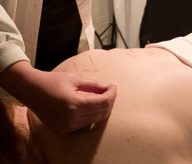Acupuncture can be used to treat many disorders, but in the United States, it is most famous for its ability to control pain. There is a reason why it is best known for its pain-relieving effects. In 1971, a journalist named James Reston was travelling in the People’s Republic of China. He had received an emergency appendectomy and was suffering from extreme post-surgical pain. To his surprise, acupuncture relieved the pain. At this time, the Western world knew very little about acupuncture. Reston wrote articles about his experience which stimulated interest in the Medical community. Most of the research that resulted involved the subject of pain control.
There are two ways acupuncture seems to relieve pain. First, it is very clear that acupuncture stimulates the release of endorphins. Endorphins are the body’s natural pain killers (endorphin means endogenous morphine). They are very potent, and they are produced naturally by the body, so they have no side effects. There is also evidence that acupuncture acts on the nervous system by blocking the transmission of pain signals to the brain. The needles do not cause pain, but they cause impulses to be sent along certain nerve fibers that reach the spinal cord and block messages transmitted by other fibers. These messages do not reach the brain, where they would be interpreted as pain.
It is, of course, not always desirable to get rid of pain. Sometimes pain serves a useful purpose. It can tell us something is wrong, as for example in the case of appendicitis, or keep us from overusing an arthritic knee. But in many cases it serves no useful function. Often pain persists long after an injury has healed, and in the case of chronic problems, it can be persistent and severe, destroying the quality of a person’s life. Acupuncture can then be very useful.
For acute conditions, such as injuries, permanent pain relief often results after only a small number of treatments. For chronic conditions, progress is slower but progressive. After a series of treatments, some patients are pain free and stay that way. Others may need periodic follow-up treatments to manage the pain in a drug-free way.
Acupuncture does not just relieve pain but in many cases also helps with the healing process. It stimulates the circulation of blood and healing energy in the diseased area. The idea of healing energy, called qi in the Chinese language, is not popular in Western medicine, which comprehends the body and mind only in biochemical terms, but it is an important part of acupuncture theory, as well as many other traditional healing systems. When the qi of the body is balanced, other health problems seemingly unrelated to the pain often begin to improve.
What painful conditions does acupuncture treat? It is used effectively for the following:
- Back pain
- Sciatica
- Neck pain
- Shoulder pain
- Knee pain
- Headache
- Toothache
- Post-herpes neuralgia
- Athletic injuries
- Accident injuries
Acupuncture treats many diseases that do not necessarily involve pain. The World Health Organization (WHO) recognizes forty conditions that respond to acupuncture care, including hypertension, digestive disorders, respiratory disorders, allergies, chronic fatigue, pre-menstrual syndrome, nicotine and drug addiction, alcoholism, sexual dysfunction, stress disorders and depression. For more information, see What can Acupuncture treat?
